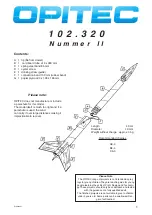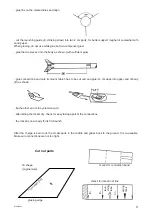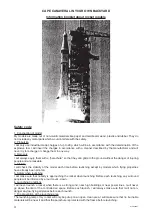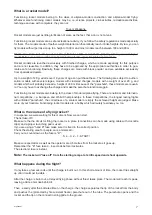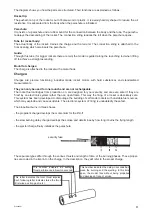
7
E102320#1
What is a rocket model?
Functioning rocket models belong to the class of airplane-model construction and airplane-model flying.
Whatever else functioning rocket models may be, i.e. science projects, club activities, recreational activities,
technique and use with computers, they are not:
Tovs or Weapons.
Rocket models are just as little glorification of wars, as the fact, that a car is not a tank.
Functioning rocket models are a safe recreational activity, if you follow the safety regulations made especially
for them. The models made of feather-weight material can theoretically reach infinite heights. By law, you can
fly models without permission up to a height of 330 m and most models reach between 100 and 300 m.
Please also make sure that you have the permission of the owner of the property where you launch your
model. Mike sure not to launch near airports, homes for the aged, hospitals or power lines.
Rocket models are launched exclusively with finished charges, which are made especially for this purpose
and are not reusable. In addition, they have to be approved by the appropriate authorities in order to gua-
rantee safe functioning. Basically, these charges are made with black powder and are available exclusively
from specialized dealers.
Up to a weight of 20 g, adults over 18 years of age can purchase these. The following are subject to authori-
zation: models with several stages, models with clustered charges, models with a weight of over 20 g, and
models which will probably exceed a height of 330 m. Because of the "parachute", these models are reusab-
le. You only have to exchange the charge and make the parachute functionaI again.
Functioning rocket models also belong to the class of model airplane flying. There are national and internatio-
nal competitions, i.e. European and World Championships. In these Competitions, the longest lasting flights
with unfolded "parachute", the correctness of a scale model or simply the achieved height are judged. Make
more of your freetime. Functioning rocket models are a hobby which will surely fascinate you, too.
What is the course of a flying rocket?
In suspense, we were waiting for this moment. Now we can start.
The fist take-off!
Make sure the the circuit for firing the rocket is in place (connections can be made using cable with crocodile
clips) and a proper launching pad is used.
If you are using a "hand lit" fuse make sure it is fixed in the correct position.
Check the staring area for people, cars, animals etc..
Carry out a count-down as the fuse is "lit":
5...4...3...2...1...START!
Make sure spectators as well as the operator are 3,5 metres from the rocket as it goes up.
Remember the "lit" fuse take 3 - 6 seconds before it activates.
The electronic fuse is instant.
Note:
The rocket will "take off" from the starting ramp at a terrific speed and shoot upwards.
What happens during the flight?
It only takes a few seconds until the charge is burnt out. In this short amount of time, the rocket flies straight
up until it is almost invisible .
After the charge is burnt out, a delayed flying phase without thrust takes place. The model will reach its peak,
leaving a trace.of smoke behind it.
Then - exactly after the indicated time on the charge - the charge separates the tip of the rocket from the body
and pushes the (protected by fire-resistant fleece) parachute out of the tube. The parachute opens and the
rocket and the tip on the connectin string glide to the ground.
Summary of Contents for 102.320 Nummer II
Page 10: ...10 E102320 1...

